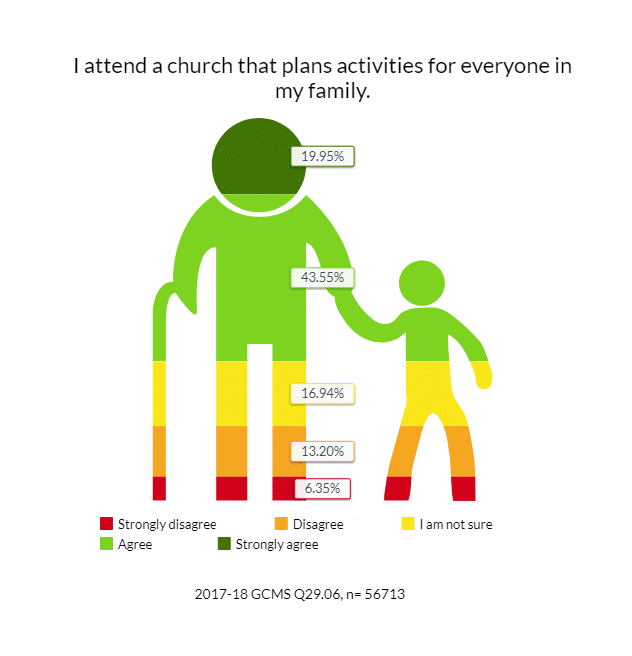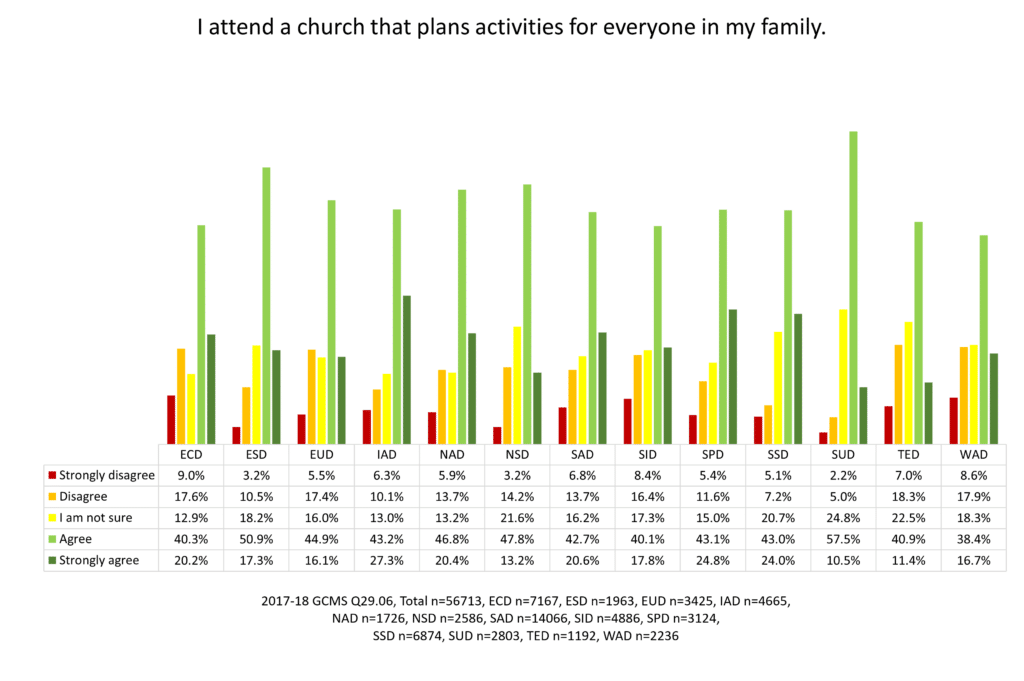The pastor and local church leaders are entrusted with the responsibility of providing carefully planned Sabbath activities for children, youth, adults, and the elderly; and for families and singles, emphasizing the importance of making the Sabbath a day of joy, worship, and rest. Church activities should complement, rather than replace family and home activities.[1]
The Adventist Church places a high value on local churches, engaging all members of the family in activities. After all, Adventist Fundamental Belief #23 states that “increasing family closeness is one of the earmarks of the final Gospel message.”[2] While such engagement is clearly held in high value, how do local churches measure up when it comes to actually planning and implementing such activities?
Global Data
The 2017–2018 Global Church Member Survey (2017–18 GCMS) assessed church members’ experiences as part of the church body. One area evaluated was members’ perception of activities at their church. The 2017–18 GCMS asked members to respond to the statement, “I attend a church that plans activities for everyone in my family.” Nearly two-thirds (64%) of members agreed globally to one degree or another that their church plans family-inclusive activities. However, one in five (20%) respondents disagreed that their church plans activities for everyone in their family, and just under one-fifth (17%) were unsure if such activities even exist in their local church.

A Closer Look by Division: The Good News
When responses to the statement“I attend a church that plans activities for everyone in my family” were cross-tabulated by Division, some interesting trends emerged.

Respondents from the Inter-American Division were most likely (71%) to agree to one degree or another that their church involves the whole family when planning activities; the Euro-Asia Division, the Southern Asia Division, and the Southern Pacific Division were close behind, with 68% agreeing or strongly agreeing. The North American Division and Southern Asia-Pacific Division were closely following them with 67%. Interestingly, the highest rate of those who strongly agreed, about a quarter, was in the Southern Pacific and Southern Asia-Pacific Divisions. It is encouraging that members in these Divisions attend churches where the call to involve the whole family is taken seriously and is carefully considered when planning church activities.
A Closer Look by Division: The Not-So-Good News
However, responses of those who were not sure or disagreed that such activities were taking place in their congregations (about 30% or more in each Division) should not be overlooked. There were also Divisions that reported much lower degrees of family involvement in church activities. In fact, approximately a quarter of respondents in each of these three Divisions disagreed to one degree or another that their church plans activities to involve the whole family:
- West-Central Africa Division (27%)
- East-Central Africa Division (27%)
- Trans-European Division (25%)
Interestingly, many members indicated that they were not sure if their church planned activities for the whole family. Is it possible that such activities are not clearly communicated and thus, the members are unaware of such activities? Almost a quarter of respondents in each of these Divisions—the Southern Asia Division (25%), Trans-European Division (23%), Northern Asia-Pacific Division (22%), and Southern Asia-Pacific Division (21%), stated that they were unsure if their church planned activities to involve the whole family.
In these cases, it is very likely that even if their local church does successfully plan activities for the whole family, the respondents are not involved in them. The questions to be asked, then, are these: Why are they not involved? Are these respondents not interested in church activities or has no one made them aware of them or has nobody invited them to participate?
The Meta-analysis of the 2017–18 GCMS data showed that “church activities for the family are very important for satisfaction with the local church—analysis showed that a predictor of being satisfied with the local church was agreeing that the local church had programs for the family; r=.20. Of those who strongly agreed that their local church provided family programming, 86% were satisfied with their local church compared to 58% who strongly disagreed that their local church had family programming. Of those who strongly disagreed that their local church had family programming, 23% were dissatisfied, compared to only 6% of those who strongly agreed that their local church had family programming.”[3]
When you consider the activities your church plans, do you feel that they include the whole family? Do these activities uphold the Adventist values of increasing family closeness? And do you, yourself, and your family, attend and support these activities? If not, what are some ways you can support your church in this important area?
Created in collaboration with the Institute of Church Ministry.
Published on 04-26-23
[1] Reid, G. W. (n.d.). Sabbath Observance—Guidelines. Seventh-day Adventist Church Biblical Research Institute. https://www.adventistbiblicalresearch.org/materials/sabbath-observance-guidelines/
[2] General Conference of Seventh-day Adventists. (2020). 28 Fundamental Beliefs.https://www.adventist.org/wp-content/uploads/2020/06/ADV-28Beliefs2020.pdf
[3] Karl G. D. Bailey, Duane C. McBride, Shannon M. Trecartin, Alina M. Baltazar, Petr Činčala, René D. Drumm, The Meta-Analysis Report, p. 88 https://www.adventistresearch.info/research-reports/research-projects-commissioned-by-general-conference-officers/presentations-by-date/

